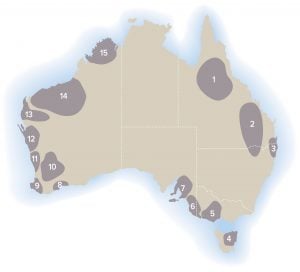Biodiversity: Biological diversity
Biodiversity refers to the variety of lifeforms native to a geographical area.
Western Australia’s globally unique biodiversity
Western Australia (WA) has a globally unique biodiversity characterised by significant regional endemism, meaning that we have plants and animals that only live in a particular location. This is due to the State’s geographical expanse, climatic diversity, areas of relative wilderness, regions with extremely nutrient-impoverished soils, and the fact that significant areas of WA have not been covered by sea or glaciated over geological time.
Eight of Australia’s 15 declared biodiversity hotspots are in Western Australia. The South West of WA is an internationally recognised biodiversity hotspot. WA has one of the highest rates of species discovery in the world and more are being discovered all the time.
By way of example, there are more species of flowering plants in the Fitzgerald River National Park than in the United Kingdom, contributing to the South West of WA being one of only 34 Global Biodiversity Hotspots (and the only in Australia), defined as geographical regions that have at least 1,500 vascular plant species and have lost at least 70% of their original supporting habitat.
Australia – Biodiversity Hotspots
Australia is one of the most biologically diverse places on Earth. It is home to between 600,000 to 700,000 species, most of which are endemic to Australia, which means they are found nowhere else in the world.
The map on this page shows all the Biodiversity Hotspots in Australia and corresponds to the list below.
- Einasleigh and Desert Uplands (QLD)
- Brigalow North and South (QLD and NSW)
- Border Ranges North and South (QLD and NSW)
- Midlands of Tasmania
- Victorian Volcanic Plain
- South Australia’s South-East/ Victoria’s South-West
- Mt Lofty/Kangaroo Island (SA)
- Fitzgerald River Ravensthorpe (WA)
- Busselton Augusta (WA)
- Central and Eastern Avon Wheatbelt (WA)
- Mount Lesueur-Eneabba (WA)
- Geraldton to Shark Bay sand plains (WA)
- Carnarvon Basin (WA)
- Hamersley-Pilbara (WA)
- North Kimberley (WA)

Ecosystems and species are under threat
High value biodiversity is at escalating risk though a range of processes including:
- Land-use change for urbanisation, agricultural, minerals and industrial development.
- Introduction of exotic plants and animals, and disease.
- Changes in the environment including altered fire regimes, changed hydrological processes and broader climate change.
The State of Australia’s Environment
2021 State of the Environment Report
Overall, the state and trend of the environment of Australia is poor and deteriorating because of increasing pressures from climate change, habitat loss, invasive species, pollution and resource extraction. Read more 1. DCCEEW-SOE_factsheet_Overview